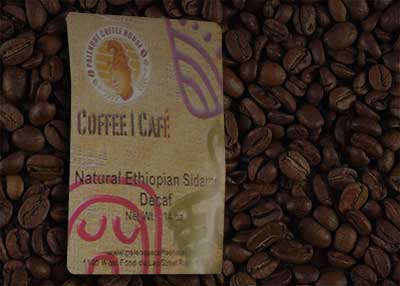Posted on Feb 20, 2012

Not all of Africa’s coffee production is limited to Robusta, however. Here’s an overview of the different coffee varieties that are grown frequently across the African continent (keep in mind that while some of these coffees are considered single origin in nature, most like Arabica and Robusta are not): Sadamo: A type of Arabica (which you can find elsewhere in this list) grown as a single origin coffee source in Sadamo, Ethiopia, this variety of coffee is a small bean that produces a rich, spicy and almost chocolatey flavor. Individual types of Ethiopian Sadamo include Yirgachefe and Guji, both known to be of high quality. Another type of Ethiopian coffee is Harar, which is another Arabica but not grown in Sadamo. More on these types of coffees later. Liberica: Coffea Liberica is a species separate from Arabica as well. It typically grows in the western areas of Africa – most notably Liberia. Liberica’s taste is closer to Robusta than that of Arabica, and the beans grow on trees that can grow as high as 10 to 15 meters tall. Gros Idente: Similar to Liberica, Gros Idente coffee is grown in large trees in the western areas of Africa, such as the Ivory Coast. Arabica: Yes, for all of our talk about Robusta growing in Africa, it can be easy to forget that Arabica coffee is also grown in Africa. Typically, the environments suited for growing Arabica in Africa are in mountainous areas – places like the mainland of the Ivory Coast and Cameroon are typical spots where Arabica coffee is grown. Excelsea: Like Liberica coffee, these trees grow high. In fact, they are also grown in the Ivory Coast which contributes to much of their similarities to Liberica and Gros Idente coffees. Robusta: Much of the African environment is suitable for Robusta growing, typically the lower-lying areas in the equatorial regions of Africa. Robusta is grown just about everywhere from Madagascar to Gabon – even if Vietnam is a leading producer of Robusta coffee, its African roots are hard to shake off. Kouilou and Petit Indenize: Grown inland along the Ivory Coast, these are actually smaller coffee trees. Bourbon: This type of coffee was already mentioned before, but its influence in African coffee is difficult to understate. Bourbon was planted in Reunion – an island off the eastern coast of Madagascar – in the 18th century. The type of coffee then mutated, producing Bourbon coffee, which was then moved around the world and cultivated in different areas. French Mission: This refers to a type of Bourbon coffee that was planted by French missionaries in areas of East Africa around the turn of the 20th century. A Kenyan type of this coffee known as K7 is also grown in Africa. Mayaguez: Another subset of Bourbon coffee, this coffee is grown in Rwanda. Typically, the Bourbon coffees planted in Africa are...
Read More »
Posted on Feb 16, 2012

Africa is part of the “cradle of civilization.” It’s also part of the cradle of coffee, considering that the original coffee plants were native to northeastern Africa even before coffee became a popular drink and something to be cultivated worldwide. As legend states, it was an Ethiopian goat-herder named Kaldi who first noticed the energizing effects of coffee beans when his goat became rambunctious after chewing on the berries of a Robusta plant. Although other legends put the origins of coffee in Arabia, it’s hard to deny that Africa’s importance in the history of coffee is as integral as the ideas of roasting or brewing. So what does single-origin coffee from Africa look like today, and how did it get that way? What is it about single-origin coffees from Africa that make African-grown coffee distinct from coffees grown in Asia or South America? Throughout this section, we’ll explore exactly what it is that African-originating coffee different from its counterparts across the...
Read More »
Posted on Feb 9, 2012

As we’ve stated in previous blog posts, the word coffee comes from an Arabic phrase meaning “the wine of the bean.” In that way, you see why it’s so important to understand single origin coffee the same way wine lovers learn grape varieties and origins: true appreciation of coffee is not complete until you know where it came from. Unfortunately, while coffee is popular in the 21st century, true appreciation of it is not. How many people drinking Vanilla Lattes know that their beans were likely Italian Roasted? How many people even know what an Italian Roast is? The modern state of coffee, while allowing for wide access to the bean, is not necessarily something that a true coffee aficionado would appreciate. It is through single-origin coffee that the purest, most historically-true coffee is tasted, appreciated, and savored. In fact, the industrialization of coffee was the one development that cast aside traditional single-origin coffee; before then, almost all coffee was single-origin coffee. If you want to really know your single-origin coffee, you’re going to have to re-learn a number of things that have been forgotten over the last century even by the most stringent of coffee lovers. You’re going to have to learn about the origins themselves and learn what...
Read More »
Posted on Feb 6, 2012

In addition to variations in single origin coffee types because of geography and other factors (which we’ll continue to explore throughout this guide), modern coffee is now largely separated based on the type of roasting and brewing. Roasting Types Because green coffee in its natural state does not taste much like what we would consider “coffee” at all, the degree to which coffee beans are roasted has a dramatic impact on the type of flavor profiles produced. Here is a brief summary of the types of roasts available: Green Coffee: Coffee, essentially, at room temperature – the beans are still green, the flavor is bitter, but the coffee can be stored up to two years like this. Arabian or Drying Roast: The mildest of the roasts at 329 degrees Fahrenheit, the beans turn green-gold as the water evaporates. Keep in mind that Arabian coffee is roasted usually between this stage and the American Roast, so this single stage is not a comprehensive “Arabian” stage by any means. Cinnamon Roast: At 383 degrees Fahrenheit, the coffee finally turns a light shade of brown – or “Cinnamon” – and the expected flavors begin to develop lightly. New England Roast: 401 degrees Fahrenheit. This is the roast that stops roasting after the beans first crack, right before the American Roast stage. American Roast: This is far more common in the United States, but not much further along the line than the New England Roast. City Roast: Now we have entered the territory of truly popular roasts; most of the U.S. utilizes this kind of roast, at which point the single origin of the beans is much more apparent than earlier in the roasting process. About 428 degrees Fahrenheit. Full City Roast: Now the second crack is beginning; essentially a deeper roast version of the City Roast. Vienna Roast: Not far beyond the Full City Roast, the Vienna usually stops in the middle of the second cracking of the beans. The acidity of the coffee beans starts to take a backseat at this stage. French Roast: The beans at 464 degrees Fahrenheit are now a fully dark brown and a little “burnt” taste may start to develop. Although this is popular in Espresso, it is not as frequently used for that purpose as… Italian Roast: 473 degrees Fahrenheit, the beans are dark brown and nearly black and all of the acidity is nearly vanished. Most Espresso coffee blends will have been roasted to this stage. Spanish Roast: About as dark as it gets; generally, this is the most “burnt” flavor a coffee drinker can tolerate before the beans lose their flavor and the burnt flavor begins to dominate. Brewing Styles Coffee can be brewed in so many ways that it’s impossible to list them all here; instead, it may be more appropriate simply to summarize some of the most popular brewing styles utilized...
Read More »
Posted on Feb 2, 2012
One more note on areas in which coffee is grown: there are a couple of factors that can influence the yield of an area’s coffee-growing potential. First, many local coffee farmers can face a lot of challenges in growing coffee because of slow yield – sometimes as long as two to five years. Their place in the world with respect to political and financial issues can also create a number of challenges for growing coffee; many underdeveloped countries often produce great coffee and could produce more if it were not for these challenges. Other challenges faced by coffee growers include the fact that coffee plants are considered highly “parasitic” in that they absorb and demand much of the nutrients in the available soil, depleting the resources available for other plants and trees. This means that coffee plants are difficult to plant around other plants that may yield valuable crops as well. In many cases, farmers simply grow coffee because it’s so hard to grow other plants along with the...
Read More »
Posted on Jan 30, 2012

Today, the world is still split between the two major types of coffees: robusta and arabica, or Coffea canephora and Coffea arabica. Many people prefer the taste of arabica coffee, but robusta coffee – though considered more bitter – is believed to have a fuller “body.” For this reason, both types of coffee are still cultivated worldwide, with different countries cultivating more of one or the other. In some cases, countries will cultivate large amounts of both types of coffee. All types of coffee in their unroasted form are called a term that is known as green coffee. Green coffee: Term used to refer to coffee beans that are unroasted. In their natural state, coffee beans are actually green, though they turn dark brown and then black when roasted. In judging which countries cultivate and produce the most amount of coffee, the term “green coffee” is often used. In the most recent available data (2010), the top producers of green coffee by weight were: Brazil: 2.8 million tonnes Vietnam: 1.1 million Indonesia: 801,000 Colombia: 514,000 India: 290,000 Ethiopia: 270,000 Peru: 264,000 Guatemala: 257,000 Mexico: 253,000 Honduras: 229,000 As you can see, the top producers of coffee tend to be equatorial (or near-equatorial countries) that have the ideal climate, soil, and altitudes for growing...
Read More »






